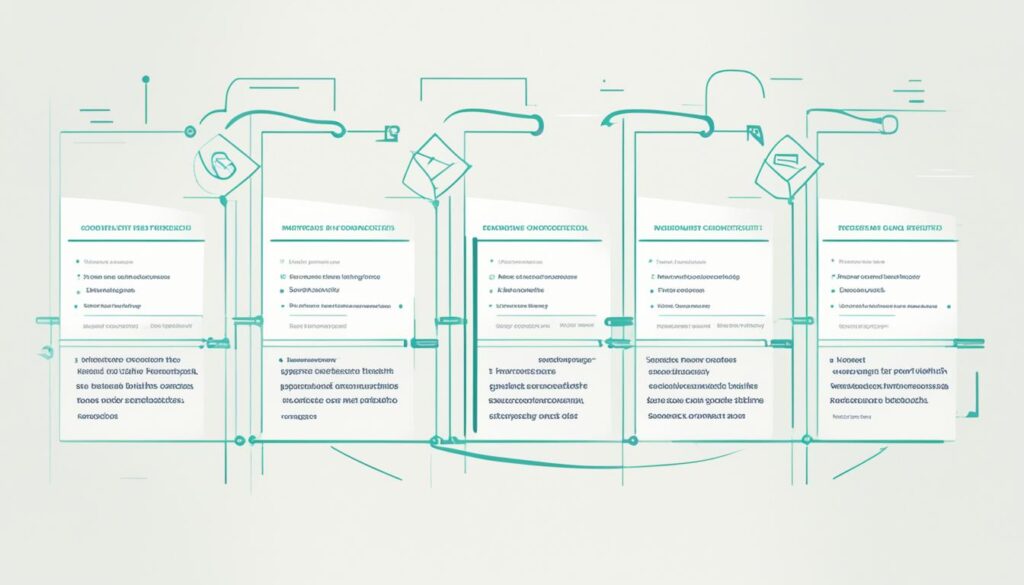
In today’s world, a website that’s friendly to SEO is key. This means your site is nice for people and search engines. It helps your web page show up more online, making it better for everybody. This guide will show you how to do it so your site shines brightly among the rest.
Key Takeaways
- SEO-friendly web design focuses on creating a website that is optimized for search engines, improving online visibility and driving more organic traffic.
- Responsive and mobile-friendly design is essential for delivering a seamless user experience and aligning with search engine algorithms.
- Enhancing the user experience and site structure, including content organization and navigation, can positively impact SEO.
- Optimizing page speed and website performance is crucial, as search engines prioritize fast-loading websites.
- On-page optimization, including metadata, alt text, and semantic markup, helps search engines better understand and index your website’s content.
Understanding SEO-Friendly Web Design
In the modern world, an SEO-friendly web design is key for companies. They want to be seen more online and bring in the right audience. This kind of design makes sure your website looks good, works well for users, and shows up high on search results.
What is SEO-Friendly Web Design?
SEO-friendly web design means making a website with SEO in mind. This helps the site get noticed more by search engines. It leads to more people coming to the site naturally, which can mean more business.
The Importance of SEO in Today’s Digital Landscape
Nowadays, search engine optimization is vital for digital marketing. Many people use search engines to find what they need. With good SEO and web design, a business can be seen online more easily. This can lead to more visitors and more sales.
Responsive and Mobile-Friendly Design
Today, many use mobiles to browse online. So, a site must be good for both responsive design and mobile optimization. This is key for SEO success. Sites that work well on all devices rank better. Google knows people want easy, smooth online times. Bad online experiences make people leave.
Why Responsive Design Matters for SEO
Responsive design means your site looks good on any device. It makes your site more user-friendly. Also, search engine algorithms can read and understand your site better. This makes your site more likely to show in search results.
Optimizing for Mobile Users
Many people use phones and tablets to go online now. So, your site needs to work great on these devices. Make sure it loads fast and is easy to use. Also, have content that’s simple to read. This makes your site better for users and boosts SEO.
User Experience and Site Structure
Good SEO-friendly web design helps users. It makes the user experience (UX) better. A clear content hierarchy and simple user-friendly navigation make a big difference. They can make using the site better and help with SEO.
Creating a User-Friendly Navigation
Making the navigation easy to understand is key. It means putting your website’s content in a logical order. Use simple names for menus. Help users find what they need easily. This makes it better for both people and search engines.
Content Organization and Hierarchies
A well-done content hierarchy is also important. It makes your site easy to use. Plus, it helps search engines understand your site better. Use heading tags well. This helps organize your content. It makes things clear for everyone.

| Key Aspects of User-Friendly Site Structure | Benefits |
|---|---|
| Intuitive Navigation | Improved user experience, enhanced crawlability for search engines |
| Clear Content Hierarchy | Easier information architecture, better understanding for search engines |
| Logical Organization of Content | Enhanced usability, improved findability of information |
| Responsive and Mobile-Friendly Design | Optimal user experience across devices, compliance with search engine guidelines |
Page Speed and Performance
In today’s fast digital world, how fast your site loads is very important. For SEO, both your website’s page speed and performance are key. Faster sites give users better user experience. Slow sites make users leave, hurting satisfaction and engagement.
The Impact of Page Speed on SEO
Faster site speed helps your site rank better on search engines. Search engines aim to show the best results quickly. Slow sites make people leave faster. By making your site faster, you can be more visible and attract more visitors.
Techniques for Improving Site Speed
To boost your website’s speed, try these tips. First, make your images and videos smaller. This will speed up your site. And, try to use fewer requests to the server. Also, save copies of your site on users’ browsers, a trick called caching. Use CDNs to deliver your content faster. Checking your site’s code is also crucial. Remove what’s not needed and ensure your hosting can support fast loading. These steps will all help improve site speed and make your site better for users.
SEO-Friendly Web Design
SEO-friendly web design makes your site seen more on search engines. It uses title tags, meta descriptions, header tags, and alt text for images.
Optimizing On-Page Elements
Good title tags and meta descriptions draw people in. They are the top links in search results. Use relevant keywords to make them effective.
The Role of Metadata and Alt Text
Also, metadata and alt text help your site rank better. Optimize alt text in images. This not only improves image optimization but also tells search engines about your page’s content.
Semantic Markup and Structured Data
SEO-friendly web design uses semantic markup and structured data. Semantic HTML means we use tags that show content’s meaning and not just how it looks. This helps search engines understand our site better.
The Benefits of Semantic HTML
Header, nav, article, and footer tags help search engines. They let search engines know what each part of our page talks about. This makes it easier for search engines to organize and show our page in search results.
Also, using semantic HTML helps people who use screen readers. It makes our website easier to navigate for them. They can understand our content better.
Implementing Structured Data
Structured data, like schema markup, is also great for SEO. It gives more info about your page to search engines. This includes what the content is about and how it’s related.
This leads to better search result displays. Things like rich snippets and knowledge panels. It can make more people click on your site. So, using structured data and semantic markup makes your site more visible and user-friendly.

| Semantic HTML Element | Meaning |
|---|---|
| header | Defines the header section of a document or a section |
| nav | Defines a section of navigation links |
| article | Defines an independent, self-contained content item |
| footer | Defines the footer section of a document or a section |
Crawlability and Site Architecture
Making your website easy for search engines is key. They use crawlers to check out your site. A good design will help these crawlers find and understand your pages. It’s all about making clear paths and connections.
Creating a Search Engine-Friendly Site Structure
Focusing on your site structure is important. To make your site easier to move around for crawlers, set up a clear plan. Use simple URLs and connect pages that relate to each other. This way, it’s like giving the crawlers a map to help them find their way through your content.
Optimizing for Crawlers
Optimizing further, you can help crawlers by doing two things. First, give them an XML sitemap. It shows them all around your site fast. Second, use a robots.txt file to guide them. Tell them where to go, and where not to go, on your site.
| SEO-Friendly Site Architecture Elements | Description |
|---|---|
| Site Structure | Organizing content in a logical hierarchy with clear navigation |
| Internal Linking | Establishing connections between related pages to improve crawlability |
| XML Sitemaps | Providing a roadmap for search engine crawlers to index website content |
| Robots.txt | Communicating instructions to crawlers about which areas to access and index |
Content Optimization and Keyword Strategy
Crafting a website that’s good for SEO needs careful planning. It involves using the right words that people often look for. This way, your site can show up more on search engines like Google.
Conducting Keyword Research
Successful content optimization starts with good keyword research. Tools like Google Keyword Planner help find popular words for your topic. Understand what people want when they search. This helps your content meet their needs.
Incorporating Keywords Naturally
Finding the best keywords is one thing. Using them well is another. It’s essential to add them in your content in a natural way. Don’t just put them anywhere. This can make your website less liked and lower its rank on search results.
Instead, use keywords in a way that makes sense in your texts, headings, and descriptions. This makes your site more interesting and useful. It also helps people find what they’re looking for, improving their experience.
Thinking about content optimization and keyword integration carefully improves your website’s search result ranking. This, in turn, brings more visitors to your site. Better yet, these visitors are more likely to act, like buying something or reaching out to you.
Link Building and Off-Page SEO
On-page SEO is important, but off-page SEO matters too, especially link building. Having lots of good, solid links to your site can make it show up more in searches. This boosts how many people see your site online.
The Importance of High-Quality Backlinks
Google and other search engines really like when your site has good links pointing to it. When important sites link to yours, it shows your site can be trusted. This can make your site look better in search results. Getting these good links from places like industry publications or popular bloggers can really help your site.
Strategies for Building Authoritative Links
There are good ways to get these quality links, like making great content or reaching out to big names in your field. Posting awesome stuff or writing for other big websites can get you noticed. It can lead to more people linking to your site, making your site seem more important in searches.
Off-page SEO is also a big part of good design. Quality links to your site can boost your ranking and visibility.



